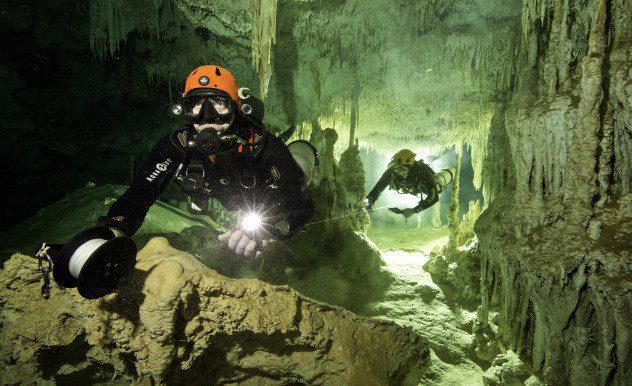With a length of 347km, Sac Actun has been claimed by a dive-team as the world’s largest flooded cave after they succeeded in connecting it with another flooded system, near the resort town of Tulum in eastern Mexico.

The team from the Great Maya Aquifer Project (GAM) say that they managed to link the two already massive systems of cenotes, Sac Actun and Dos Ojos, on 10 January.
When two cave-systems are connected, the convention is that the largest absorbs the smallest, so Dos Ojos now loses its name.
The breakthrough was the culmination of an intense diving operation that began last March.
GAM’s Exploration Director Robert Schmittner, who led a team of cave-divers including Marty O’Farrell, Jim Josiak and Sev Regehr, says he had been seeking the connection for 14 years, gradually adding new tunnels and galleries to the “underwater labyrinth”.
“This immense cave represents the most important submerged archaeological site in the world, as it has more than 100 archaeological contexts, among which are evidence of the first settlers of America, as well as extinct fauna and, of course, Mayan culture,” said GAM Director Guillermo de Anda.
Until the breakthrough Ox Bel Ha was the longest of the local cenote systems at 270km, followed by Sac Actun at 263km, Kook Baal at 93km and the 83km Dos Ojos.
There are 358 known systems in the north of Quintana Roo, covering some 1400km and providing much of the state’s fresh water.
As a result of its recent diving operation, GAM has also discovered an 18km cave system north of Sac Actun with a maximum depth of 20m that it calls “The Mother of all Cenotes”. It says that it is “very close” to connecting this with Sac Actun, which it also hopes to be able to connect with three other underwater systems around Tulum.
* A CANADIAN team has penetrated and mapped what it is calling Canada’s deepest cave, Bisaro Anima, near Fernie in British Columbia. Expedition leader Kathleen Graham is reported to have reached the cave’s record depth of 670m by diving through a sump, though it is thought that the cave could eventually prove to be more than 1000m deep.
The Bisaro Plateau Caves Project was started by the Alberta Speleological Society in 2002, and its explorers have so far penetrated 5.3km into what they also believe could turn out to be Canada’s longest cave.
Divernet – The Biggest Online Resource for Scuba Divers
17-Jan-18
